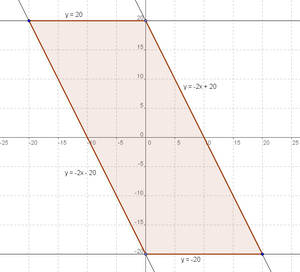Difference between revisions of "1998 AIME Problems/Problem 3"
(→Solution) |
(→Solution) |
||
| Line 19: | Line 19: | ||
Hence, either <math>y = -20</math>, or <math>2x = 20 - y \Longrightarrow y = -2x + 20</math>. | Hence, either <math>y = -20</math>, or <math>2x = 20 - y \Longrightarrow y = -2x + 20</math>. | ||
| − | Similarily, for the second one, we get <math>y = 20</math> or <math> y = -2x - 20</math>. If we graph these four equations, we see that we get a parallelogram with base 20 and height 40. Hence the answer is <math>800</math>. | + | Similarily, for the second one, we get <math>y = 20</math> or <math> y = -2x - 20</math>. If we graph these four equations, we see that we get a parallelogram with base 20 and height 40. Hence the answer is <math>\boxed{800}</math>. |
== See also == | == See also == | ||
Revision as of 19:37, 16 September 2016
Problem
The graph of ![]() partitions the plane into several regions. What is the area of the bounded region?
partitions the plane into several regions. What is the area of the bounded region?
Solution
We can split the equation into a piecewise equation by breaking up the absolute value:
Factoring the first one: (alternatively, it is also possible to complete the square)
Hence, either ![]() , or
, or ![]() .
.
Similarily, for the second one, we get ![]() or
or ![]() . If we graph these four equations, we see that we get a parallelogram with base 20 and height 40. Hence the answer is
. If we graph these four equations, we see that we get a parallelogram with base 20 and height 40. Hence the answer is ![]() .
.
See also
| 1998 AIME (Problems • Answer Key • Resources) | ||
| Preceded by Problem 2 |
Followed by Problem 4 | |
| 1 • 2 • 3 • 4 • 5 • 6 • 7 • 8 • 9 • 10 • 11 • 12 • 13 • 14 • 15 | ||
| All AIME Problems and Solutions | ||
The problems on this page are copyrighted by the Mathematical Association of America's American Mathematics Competitions. 










